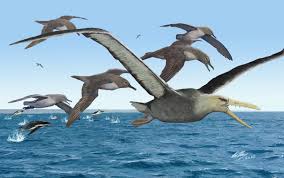Fossils recovered from Antarctica in the 1980s may belong to the largest flying bird ever, a new study has found.
Source: USA Today
Called pelagornithids, the now-extinct group of birds had wingspans of up to 21 feet –almost double today’s largest.
Ages of the fossils – ranging from 62-million-years old to 2.5 million years old – suggest that the pelagornithids arose after the mass extinction of dinosaurs.
With “bony teeth” and sharp beaks, the birds preyed on fish and squid. Researchers have determined that the pelagornithids traveled the southern oceans of the world for at least 60 million years, much like today’s albatross.
“These Antarctic fossils…likely represent not only the largest flying birds of the Eocene but also some of the largest volant birds that ever lived,” the study reports.
Published Monday in the journal “Scientific Reports,” the study explores fossils collected by University of California, Riverside paleontologists from the Antarctic Peninsula in the mid 80s – including a foot bone and partial jaw bone of what is now considered among the largest (and oldest) pelagornithids ever recorded.
According to a news release from the university, the fossils were moved to the UC Museum of Paleontology at UC Berkeley, where a graduate student, Peter Kloess, came across them in 2015.
Kloess is the lead author of the study. With his two co-authors, he used measurements of the fossils to compare on scale with previously found skeletons of pelagornithids. The team found that the fragments came from creatures as big, if not bigger, than the known sizes of the extinct bird.
“Our fossil discovery…shows that birds evolved to a truly gigantic size relatively quickly after the extinction of the dinosaurs and ruled over the oceans for millions of years,” Kloess said.
The study also helps paleontologists picture what Antarctica what like 50 million years ago. It was not the icy continent it is today – but much warmer, and home to now-extinct land mammals, including distant relatives of sloths and anteaters. The region was also a “playground” for diverse species of birds.
“The giant extinct pelagornithids, with their very long-pointed wings, would have flown widely over the ancient open seas, which had yet to be dominated by whales and seals,” said co-author Thomas Stidham of the Institute of Vertebrate Paleontology and Paleoanthropology at the Chinese Academy of Sciences in Beijing.
“These bony-toothed birds would have been formidable predators that evolved to be at the top of their ecosystem.”
Source: USA Today

































Leave a Comment
You must be logged in to post a comment.